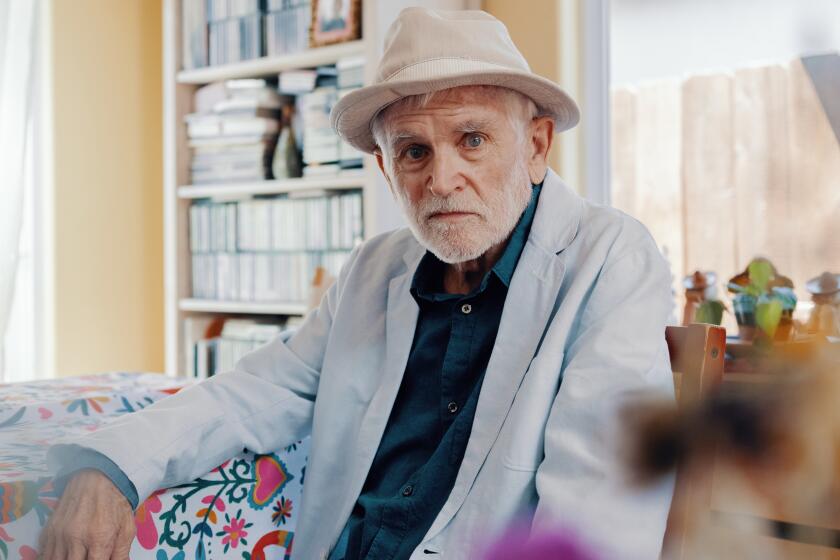A Strategic Retreat for Homeless Vets : Years of Animosity Between Former GIs and VA Officials Leads to Closing of Military-Style Camp Along Freeway
- Share via
For years the military-style encampment remained hidden in a shrub-choked gully, hard by the Wilshire Boulevard on-ramp to the southbound 405.
There, only 300 yards from the West Los Angeles Veterans Affairs Medical Center, homeless veterans spent their nights in makeshift shelters and ate their meals in a “mess tent.” The vets endured physical ailments, mental illness, drug addiction and more, but they lived on in what they called “405 Bush Camp,”--unable, or unwilling, to rejoin the society literally surrounding them.
Then, two weeks ago, local, state and federal law enforcement officials converged on the camp with a team of Caltrans workers, clearing out the vets and their belongings. The action followed years of on-again, off-again hostility between the camp and Veterans Affairs officials, a conflict that underscores the severe problems facing homeless veterans--and those who try to reach them.
Camp residents said the VA hospital failed to give them the help they need. But VA officials assert that the vets obstinately refused it, unwilling to give up life in “the bush.”
James Dwyer, director of a residential rehabilitation program at the VA hospital, said the vets built “a place that’s analogous to Vietnam.”
“For some, Vietnam was the most significant time of their lives,” Dwyer said. “The camaraderie--they try to recreate that.”
The camp had been in its most recent location for about two years, but it has existed for roughly a decade in various spots near the freeway’s Wilshire interchange, housing up to 15 men, most of them Vietnam vets.
In the weeks before it was torn down, the camp was home to vets who included Ricardo Apodaca, a member of the Army’s 82nd Airborne Division from 1968 to 1971; Harold (Bud) Thombs, who served in the Marine Corps from 1961 to 1966; Joseph Ackerly, who was in the Air Force from 1972 to 1988; Wes Hulvey, who served on a Navy aircraft carrier from 1959 to 1962, and Gerry Nebeker, who served in the Army on and off from 1966 to 1979.
The camp’s undisputed leader was Jim Bethard, called “Crazy Jim,” a controversial figure who considers the bushes his permanent home. Although Bethard claims he is a veteran, VA officials say they have found no trace of him in their military records.
The camp occupied a 60-foot-wide strip of land between the VA hospital property and the southbound San Diego (405) Freeway on-ramp. A footpath ran down the middle of the strip, and on either side of it stood tents, or “hooches”--green plastic draped over dome-shaped skeletons of white plastic piping.
Though much of the camp looked as if it had been pulled from a town dump--grimy or rusted, torn or chipped--there was an unmistakable sense of order in the layout.
And the place was peaceful, lulled by the muffled roar of freeway traffic overhead. “(The noise of the cars) almost starts sounding like a waterfall after awhile, don’t it?” Bethard asked one day before the camp was dismantled.
Camp residents could have moved to homeless shelters, but they preferred the isolation of their freeway redoubt.
“We’re all family, just like in Southeast Asia,” said Apodaca. “When I wake up screaming and crying, I know these guys understand.”
The camp served as a halfway house of sorts, with its residents staying from several days to several months--some as long as a couple of years.
Apodaca, who is recovering from heroin addiction, moved into the camp this winter after being released from a drug rehabilitation program at the VA hospital. He did so, he said, because he had “nowhere else to go.”
He was hoping to be accepted into the VA’s program for vets with Post Traumatic Stress Disorder, a psychological problem affecting many Vietnam-era servicemen. Nebeker, meanwhile, had moved to the camp in January after being treated at the hospital for various psychological problems.
“This is just temporary until I can get back into (gold) mining,” Nebeker said one afternoon before the camp was closed, clutching his coffee mug. After leaving the service, he said, he started a Sierra County gold-mining business that later failed.
Though homeless, the vets are not destitute. They receive military disability payments, pensions and Supplemental Security Income. One collected more than $1,800 a month, tax-free, in disability payments.
All the men complained that combat-related trauma prevented them from leading normal lives after the Vietnam War. They blame the war for their divorces, their drug addictions, their alcoholism and their homelessness.
Yet most also acknowledged they are treated for psychological ailments not directly related to their war experiences: Schizophrenia and manic depression are the two most common.
They also suffer from physical problems. Thombs was admitted to the VA hospital complaining of a heart condition a week before the camp was closed. Ackerly was suffering from diarrhea.
“If someone is living on the street, it’s not healthy,” said Fred Gusman, director of the National Center For Post Traumatic Stress Disorder in Palo Alto. “Some (veterans) want relief from their problems, but they don’t want to change their lifestyles.”
Daily life at the camp revolved around the “mess tent,” where the men pulled up chairs or plastic crates and sat around a metal table cluttered with papers, medicine bottles, magazines and cigarette packages.
Wooden shelves lining the back of the tent were stocked with canned goods and other non-perishable food supplies, some of it donated by local grocery stores.
Many of the supplies they had bought. Camp residents who could afford it contributed about $60 a month in cash and food stamps for necessities. By the end of each month, supplies were meager--except for the cigarettes and coffee, which they never seemed to lack.
In the mess tent one day last month, the men swapped stories as they chain-smoked and downed cup after cup of coffee heated on a Coleman camping stove. They joked about the O.J. Simpson murder trial and traded predictions about who would win the college basketball crown.
The camp received news primarily from a radio that, along with a light in the mess tent, ran on electricity from two solar panels connected to seven car batteries. The system was rigged by Bethard, who was trying to generate enough solar energy to operate a refrigerator shortly before the camp was closed.
As it was, the men kept perishable foods in coolers. Meals consisted of anything the vets had on the shelf. Usually they ate together.
There was no running water in the camp, which made it difficult to keep clean. For washing and drinking, the vets kept at least half a dozen gallons of bottled water on hand.
The men used a small portable toilet, which they periodically emptied in nearby restrooms, most often those in the VA hospital. A medicine cabinet hanging from a tree contained soap, combs and a blood-pressure kit.
On another tree hung an American flag.
Contributing to the undoing of the camp was a feisty, independent spirit fostered by Bethard.
Bethard considered the camp his own, referring to the vets as “his men” and crediting himself for the success of those who found apartments and steady jobs.
“If I wasn’t here, who’d take care of these guys?” he asked on one occasion.
Some former residents praise the camp and its leader.
“Jim gave me the shirt off his back,” said Tom Nichols, who stayed in the camp for three weeks earlier this year. Today, Nichols lives in a homeless shelter run by a nonprofit group and works as a telemarketer, but he visited the camp regularly after moving out.
Bob Raygor, who lived in the camp for three weeks several years ago, now operates a mailbox center on Sawtelle Boulevard in West Los Angeles and a TV repair shop next door.
“(The camp) is about people helping people,” Raygor said. “Jim’s a little weird, but he’s a great guy. He’d bend over backwards to help you.”
Randy Kline, a volunteer with the VA’s homeless outreach program who spent much of his free time helping the “405 Bush Camp” vets, says not all former camp residents agree.
“There’s no doubt that Jim (Bethard) has done a lot of good for some vets, but he’s also pissed off a lot of people,” Kline said.
That includes VA officials, several of whom accuse Bethard of poisoning the minds of homeless vets with his criticism of VA services.
“We’ve been working with the guys in the camp, trying to get them in here, trying to get them to abandon life on the street,” said Bill Daniels, director of the VA’s Comprehensive Homeless Center and associate chief of social work.
Said Stephen Peck, an outreach worker in the VA’s Homeless Program: “(Bethard) was a disruptive influence. Fellas weren’t coming to the VA because of him, and that’s when the camp started to bother us.”
Bethard and other camp residents complained that vets have to wait too long to get into VA care programs such as those for Post Traumatic Stress Disorder and drug addiction. And when vets do receive such treatment, they say, they are abandoned once it’s over.
“I love America, but I’m disappointed with the system across the way,” said Apodaca, referring to the VA hospital. “They’re not really trying to help us.”
Said Bethard: “These men are being denied services. They have to wait weeks to get into programs. Then they’re discharged from the hospital and they have nowhere to go.”
Daniels, however, points out that the VA provides medical treatment, psychological counseling and shelter to roughly 1,500 homeless vets a year. He ticks off a long list of programs to which homeless vets, including those who lived in “405 Bush Camp,” have access.
Among them: two in-patient Post Traumatic Stress Disorder programs--one short-term and one long-term--substance abuse programs, a transitional housing program and an outpatient veterans center on Westwood Boulevard. The VA also can refer vets to community shelters and other treatment programs statewide.
At one time, social workers regularly visited the camp, according to VA officials. But such outreach efforts came to an abrupt halt earlier this year when two of them received death threats from the men in the camp, Daniels said.
“A lot of these people, you don’t know what’s going on with them,” he said. “I became a lot more cautious.”
The vets’ use of drugs and alcohol also foiled attempts to help, the VA hospital’s Dwyer said. Vets must learn to cope without these substances before they can deal with their combat-related trauma, he said.
VA officials said they believe drugs and alcohol were present in the camp until it was torn down, despite Bethard’s claim to the contrary. Los Angeles police officers on the scene when the camp was closed said they did not see any evidence of drugs or alcohol, however.
Disagreement over the camp came to a head on March 30, when more than half a dozen officers from the LAPD, California Highway Patrol and the VA showed up at 9 a.m. and ordered the site vacated and cleaned up. Caltrans had given the men one day’s notice of the closure.
The vets seemed subdued and resigned as Caltrans workers combed the property, though there was a final show of solidarity.
Thombs, who was in the VA hospital when he heard about the shutdown, shuffled over to the camp on foot, clad in a robe and carrying a portable intravenous unit still connected to his arm. VA police promptly removed him from the site.
An LAPD officer, meanwhile, helped Bethard fold the camp’s U.S. flag, military-style.
Said Nebeker, as he watched the proceedings: “This is horrible.”
The dismantling of the camp forced most of the vets to find new homes and, in some cases, new direction.
Thombs returned to the hospital, where he remains. Apodaca was last seen leaving the camp, on his way, he said, to the West Los Angeles VA’s Post Traumatic Stress Disorder program. Nebeker went to Sacramento, saying he hoped to revive his gold-mining business.
Hulvey and Ackerly had moved to Long Beach just days before the camp was torn down. Hulvey shares an apartment there with Kline, the VA volunteer; Ackerly has been admitted to the Department of Veterans Affairs Medical Center in Long Beach to receive treatment for Post Traumatic Stress Disorder.
Bethard, however, has not abandoned his freeway haunts. On the day the camp was cleared he was seen lugging tents, the Coleman stove, car batteries and the folded U.S. flag to another spot along the on-ramp, about 150 yards away.
Asked if he would move to a shelter, he replied: “Nah.”
More to Read
Sign up for Essential California
The most important California stories and recommendations in your inbox every morning.
You may occasionally receive promotional content from the Los Angeles Times.










